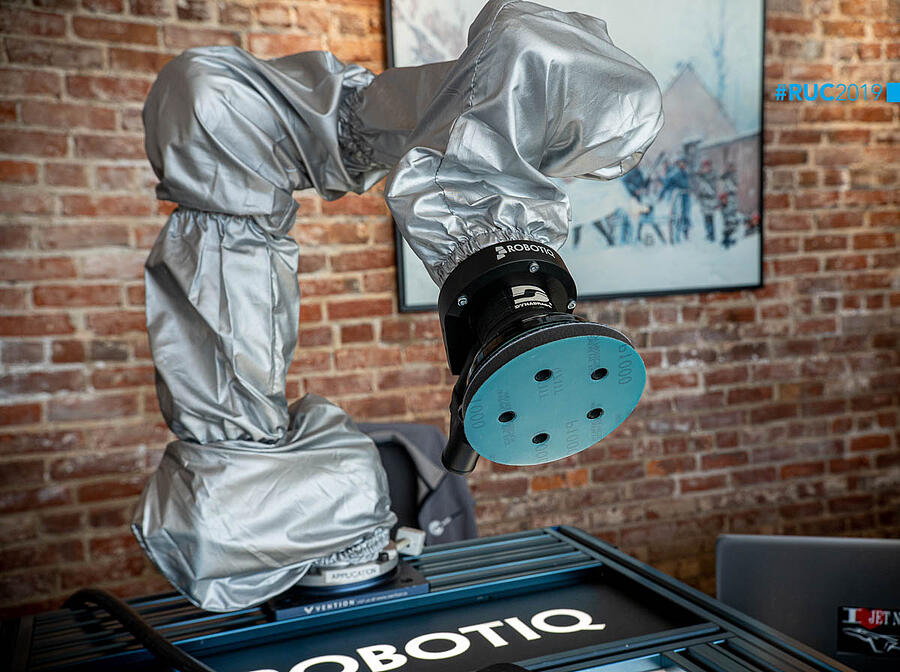Surface Finishing Cell Design
In the previous lesson, we overviewed the surface finishing cell, which was one of several possibilities. The goal of this lesson is to give you guidelines to get the best out of your cell. Let’s take a closer look at how it can be done.
Infeed/Outfeed
Parts may have to be supplied to the station in a different way than during the manual process. Multiple options can be considered:
- Racking
- Cart
- Mobile jig
- Conveyor / Production line
No matter which method is used, the process will need to be tested outside the production area to ensure proper operation.
Read more about general part presentation for cobot application in this complete Playbook on the subject
Robotiq Part Presentation Playbook
Part Position on the Working Table
An important part of the solution is to determine how the robot will locate the part that needs to be processed. 75% of the time, with the manual method, the part does not have a positioning system. For processes, the robot has to know where the part is 100% of the time. There are two main concepts:
- The part is set in place in a mechanical manner
- Positioning stop
- Dedicated jig
- Automatic positioner
- The part is detected by the robot
- Localization by a vision system
- Localization by contact
The size and the shape of your part, as well as the space allowed for the layout, will guide your decisions.
% of the Automated Task
For finishing tasks, it is very difficult to automate 100% of the process. We like to say that the best practice is to replace 80% of the manual task by a cobot.
Another good practice is to keep a worker in the cell, and to design two workstations; while the cobot is doing a part of the process, the human worker can prepare the second station and perform the remaining 20% of the tasks, including a quality inspection.
If you are still questioning yourself if you can automate your finishing application, this blog post will help you understand which surface shapes are compatible with robot finishing.
![]() Which Surface Shapes Are Compatible With Robot Finishing?
Which Surface Shapes Are Compatible With Robot Finishing?
End-of-Arm Tooling
Multiple processes with different tools and/or media can be required to complete a finishing application.
Here are different situations that you can face:
- Multiple grits (e.g., grit sizes, polishing products, etc.)
- Multiple tool shapes
- Multiple processes (e.g., sanding followed by polishing)
No matter your application, several solutions are available. You can perform an analysis to determine which one is the best for your case.
Here are some solutions that can be considered:
- Manual tool changer
- Automatic tool changer
- Multi-tool on the robot (e.g., dual sanding kit)
Quality of the Environment

The selection of your cell components can differ depending on the environment in which the cobot will work. For instance, if the cobot operates in a dusty environment, keep the following in mind:
- Cobot choice
- The cobot itself is not suitable for a dusty environment; you will need extra protection. Special jacket protection is recommended for the robot.
- Cleaning system
- To avoid dust spreading all over the place, you may consider a cleaning system such as:
- Central vacuum system
- Self-generated vacuum
- To avoid dust spreading all over the place, you may consider a cleaning system such as:
- Explosive dust
- We recommend working with a cobot integrator; this situation may require extra protection and will be very complex to make sure the workstation is safe.
Finishing Media Selection
The finishing media used to go through the tasks are very important. As you already know, depending on the task you need to automate, your tool and media selection will change. If possible, we recommend using the exact same media tool used during the manual process.
In case you need to change or upgrade your tooling, we suggest you contact your supplier; they are the experts in their tooling and media portfolio.
Tool wear is a top cause of inefficiency in many shops. What if you could reduce tool wear to a minimum? Read more about the options in this blog post: